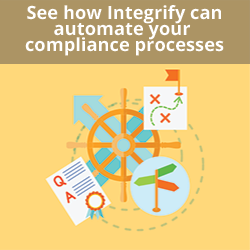Automated compliance workflows for efficiency
Table of contents

While workflow automation has many applications and provides benefits for everyone in an organization, it is arguably every compliance officer's best friend. Regardless of industry, the compliance function is responsible for ensuring that the company's policies and procedures are designed to comply with applicable laws and regulations, and ensuring that those policies and procedures are followed. There's a lot more that goes into compliance of course, but that's the essence.
As compliance regulations continue to increase in both number and scope, automating compliance workflows is almost a necessity for businesses of any size. Whether you need to comply with Sarbanes-Oxley, ISO Standards, the Gramm-Leach-Bliley Act, HIPAA, SEC, FINRA, OCC or any other regulations, here are some of the ways that automated compliance workflows can be an enormous help to compliance personnel:
Approvals
For many compliance officers, an important responsibility is reviewing and providing or denying approvals. For example, certain industries such as financial services and biotech have stringent requirements for marketing and sales materials and require pre-approval of all advertisements or other communications.
Without an automated workflow process to handle submissions, this can quickly become an onerous task involving tracking email or paper submissions as they move through the approval process. However, with an automated solution, users can submit materials which then triggers a first-level review. That reviewer can then choose to send the piece back to the submitter or can move it forward in the process.
Workflows can be built to accommodate any number of steps, any number of users, and any number of contingencies or possible outcomes. Meanwhile, there is a record of the piece that any of the involved users can access at any time, quickly and easily, cutting down on calls to compliance to inquire about the status of a submitted piece.
Audit trails
An important part of compliance in every organization is the audit process. Whether they are part of an annual testing program performed by the compliance department, targeted internal audits by another area of the firm or visits by regulatory authorities, audits are a critical and necessary function to ensure compliance.
Automated workflows can be invaluable in the audit process. First of all, there is a built-in audit trail, so every action that is taken by any user is date- and time-stamped. Workflows can also help keep track of different versions of policy documents. This can be especially important in the event of a regulatory audit covering a specific, previous time period, for which you are required to produce policy manuals in force during the audit period.
Attestations
Whether you require all new hires to read an employee manual, require annual certifications of IT policies, or need employees to certify that they have read, understood and agree to follow your code of ethics, automating workflows helps save time and resources, and helps minimize both time and the risk of human error that can occur when attestations are handled manually.
With automated workflows, you load your content, define recipients and determine response requirements up front. No more sending individual emails and tracking responses on spreadsheets. You can even set up automatic reminder notices, and employees or reviewers can add notes and comments.
 (opens in a new tab)Service provider assessments
(opens in a new tab)Service provider assessments
If your organization conducts due diligence on, selects and uses third-party service providers, you need to assess and document your review of, their capabilities and ability to provide services for you and your clients. Using an automated workflow solution streamlines that process and helps you compare and contrast providers' offerings in one place, so you can move ahead with confidence knowing your end customers are in the right hands.
Legal holds and litigation services
Workflows can also be used to keep track of legal holds, capture and retain documents, notify stakeholders, automate discovery and handle other litigation-related services so that if your company is involved in legal actions, you can focus on defending your position rather than on tracking down and safeguarding physical documents.
Just like day-to-day approvals, you can use workflows to track legal hold and litigation approvals, as well as handling conflict checks. Legal matters can be stressful, but using automated compliance workflows can help ease that stress so you don't need to worry about the process itself.
Ease for employees
Ask any employee in an environment without automated workflows about their biggest operational frustrations and you're likely to hear that they find it confusing, time-consuming and sometimes difficult to keep up with all of the various compliance requirements and tasks. When employees have to learn multiple systems and interfaces just to handle minimum compliance tasks, that takes their focus away from doing what they were hired to do for the company.
When employees have one main workflow interface for attestations, approval requests, policies, and other compliance-related responsibilities, odds are good that compliance with required policies will go up simply because you've made it easier for them to find information when they need it.
Conclusion
Not only will automating compliance workflows mitigate your organization's compliance risks, ease regulatory and litigation burdens, free up employees to focus on their jobs and make internal and industry audits simpler, using workflows will also provide cost savings for your organization. By eliminating, or significantly reducing, manual processes, you'll also be lowering the risk of human error.
With options including mobile interfaces, cloud- or firewall-based hosting, today's compliance workflow solutions are flexible and can be designed to do exactly what you need them to do, no matter how many regulations you need to follow.





